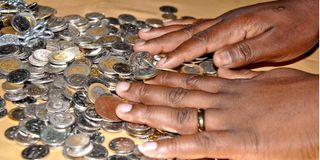Coins return to the market as broke Kenyans face tougher times

Central Bank of Kenya data shows the value of coins in circulation hit a record high of Sh10.15 billion in the year to June, a 4.1 per cent increase from Sh9.75 billion last year.
Coins circulation rose fastest in four years in the 12 months to June this year, fuelled by a heightened financial squeeze that has seen more Kenyans turn to low-value currencies to pay for goods and services.
Central Bank of Kenya (CBK) data shows the value of coins in circulation hit a record high of Sh10.15 billion in the year to June, a 4.1 per cent increase from Sh9.75 billion last year.
This is the fastest increase in circulation since 2018 when it rose by 8.54 per cent from Sh8.89 billion, up from Sh8.19 billion in June 2017.
This shows more people are using their idle coin savings to pay for low-value transactions amid a five-year high inflation rate.
Previous CBK data showed that there were some Sh995 million worth of Sh1 and 50-cent coins that are out of circulation.
These are mostly coins that are given as change during transactions but are stashed away and often forgotten.
Tough times are now forcing consumers to mop up the coins for use.
Essential goods
Inflation hit a 63-month high of 9.2 per cent in September after fuel prices jumped to a record high, driving up the cost of essential goods and services.
Kenya has five denominations of Sh1, Sh5, Sh10, Sh20, and Sh40 coins in circulation. However, CBK discontinued the printing of the Sh40 coin in December 2018 after issuing the new generation of currency coins.
CBK issued a new generation of coins and banknotes on December 11, 2018, and May 31, 2019, respectively.
The new generation currency was designed to conform to the requirements of the Constitution that was passed in 2010.
Bank notes, however, remain the most preferred means by consumers to settle payments.
Coins make up just 3.32 per cent of the total currency in circulation. In some sections of the country, retailers were rejecting Sh1 coins, leading to price distortion.
Higher currency outflows
The amount of money circulating within the country hit a record high of Sh261.5 billion in July.
“The net increase of currency in circulation was attributed to higher currency outflows (withdrawals) compared to the net inflows (deposits),” CBK said.
This reflects increased spending power even as politicians loosened the purse strings and splashed the cash on campaigns just days before the August General Election.
It’s the largest amount of money circulating outside banks in a single month since the CBK started to publicly release the data.
It’s also a 6.5 per cent increase from the Sh245.5 billion that was circulating in June, which shows Sh16 billion was released into the economy in a month.





